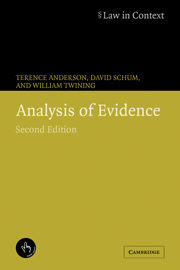Book contents
- Frontmatter
- Contents
- Preface
- Acknowledgments
- Tables of cases and statutes
- Table of legislation and rules
- List of abbreviations
- 1 Evidence and inference: some food for thought
- 2 Fact investigation and the nature of evidence
- 3 Principles of proof
- 4 Methods of analysis
- 5 The chart method
- 6 Outlines, chronologies, and narrative
- 7 Analyzing the decided case: anatomy of a cause célèbre
- 8 Evaluating evidence
- 9 Probabilities, weight, and probative force
- 10 Necessary but dangerous: generalizations and stories in argumentation about facts
- 11 The principles of proof and the law of evidence
- 12 The trial lawyer's standpoint
- Glossary of terms and symbols
- References
- Index
7 - Analyzing the decided case: anatomy of a cause célèbre
Published online by Cambridge University Press: 23 November 2009
- Frontmatter
- Contents
- Preface
- Acknowledgments
- Tables of cases and statutes
- Table of legislation and rules
- List of abbreviations
- 1 Evidence and inference: some food for thought
- 2 Fact investigation and the nature of evidence
- 3 Principles of proof
- 4 Methods of analysis
- 5 The chart method
- 6 Outlines, chronologies, and narrative
- 7 Analyzing the decided case: anatomy of a cause célèbre
- 8 Evaluating evidence
- 9 Probabilities, weight, and probative force
- 10 Necessary but dangerous: generalizations and stories in argumentation about facts
- 11 The principles of proof and the law of evidence
- 12 The trial lawyer's standpoint
- Glossary of terms and symbols
- References
- Index
Summary
Introduction
Rex v. Bywaters and Thompson is one of England's most famous causes célèbres. On January 9, 1923, Frederick Bywaters and Edith Thompson were hanged for the murder of Edith's husband Percy, just three months and six days after his death. The case is an example of rough as well as speedy “justice.” Public opinion at the time and subsequent commentators have been divided on the question whether Edith was guilty as charged and on a number of subsidiary issues.
In our experience, Bywaters and Thompson is a particularly good vehicle for classroom consideration of modified Wigmorean analysis for several reasons:
a It is interesting in itself;
b It is a good test of macroscopic analysis not only because it involves a complex mixed mass of evidence, but also because uncertainties about the law relating to aiding and abetting, conspiring and incitement, raise challenging questions about precisely what it was that the prosecution had to prove in order to establish a case that was sufficient to support a conviction in respect of Edith;
c There were several possible theories of the case available to each side;
d Several key phases of the evidence, including some passages in Edith's letters, invite careful microscopic analysis; and
e Some of the key evidentiary issues relate to what Jerome Frank called “wild facts,” that is to say issues relating to such elusive matters as motive, intent, the characters and relationships of the main actors, and the language of lovers. Edith's letters in particular provide an excellent test of the uses and limitations of careful analysis. As one student put it: “If you can analyze Edith's prose, you can analyze anything.”
- Type
- Chapter
- Information
- Analysis of Evidence , pp. 159 - 223Publisher: Cambridge University PressPrint publication year: 2005



